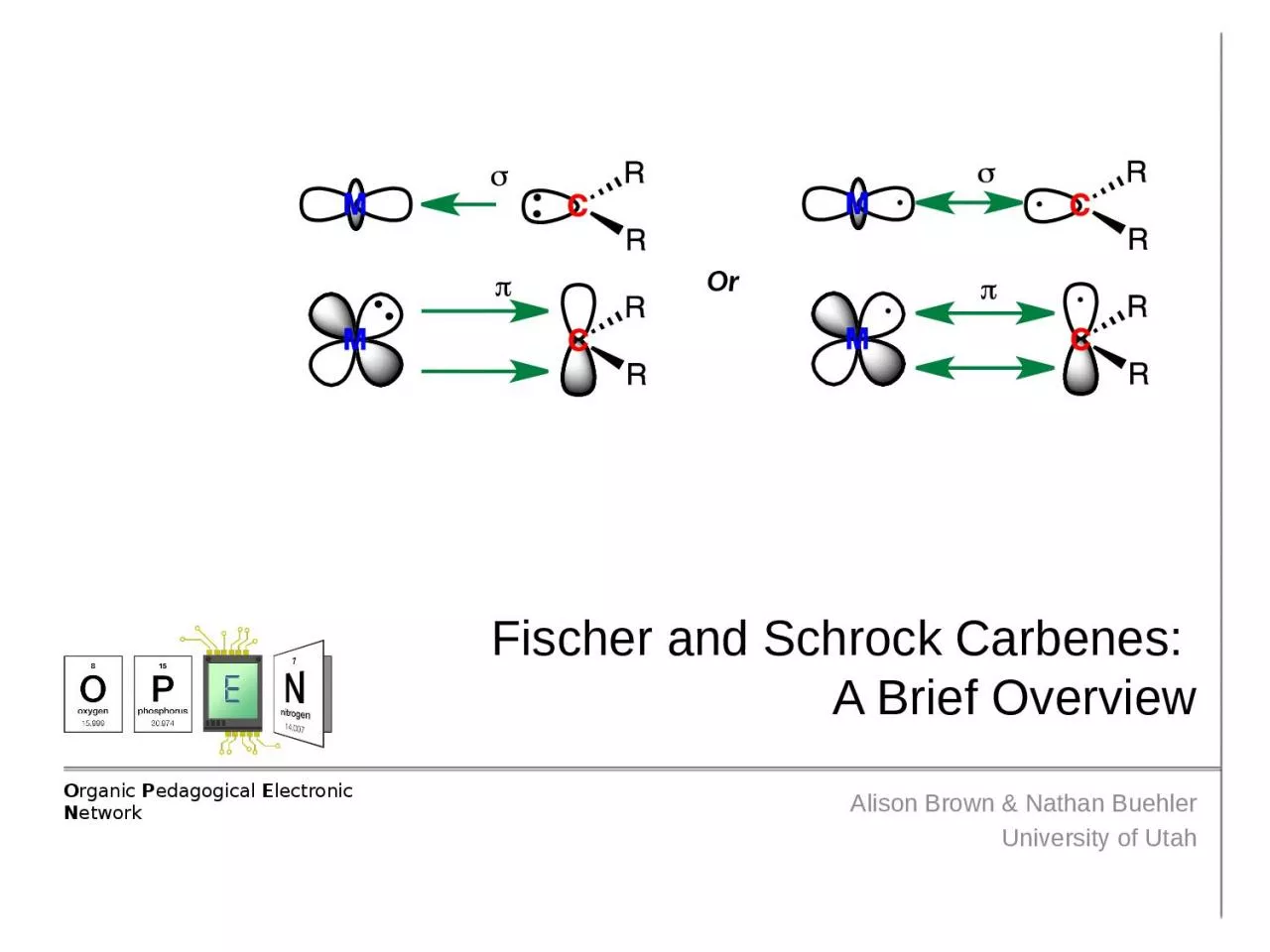

A Brief Overview Alison Brown amp Nathan Buehler University of Utah Or Free Carbenes A Brief Primer Wiki Page httpenwikipediaorgwikiCarbene Other Helpful References ID: 999992
Download Presentation The PPT/PDF document "Fischer and Schrock Carbenes" is the property of its rightful owner. Permission is granted to download and print the materials on this web site for personal, non-commercial use only, and to display it on your personal computer provided you do not modify the materials and that you retain all copyright notices contained in the materials. By downloading content from our website, you accept the terms of this agreement.
1. Fischer and Schrock Carbenes: A Brief OverviewAlison Brown & Nathan BuehlerUniversity of UtahOr
2. Free Carbenes: A Brief PrimerWiki Page: http://en.wikipedia.org/wiki/Carbene Other Helpful References: http://chemistry.caltech.edu/courses/ch242/L20.pdf, A carbene is any neutral carbon species which contains a non-bonding valance pair of electrons - The simplest example of a carbene is methylene- Traditional organic chemistry requires photolysis or thermolysis for carbene formation (specifically methylene)- Carbenes exist in either the singlet or triplet stateBoth singlet and triplet carbenes are highly reactive, reacting with all C—H and C=C bonds Singlet state carbenes have spin-paired electrons, and can be thought of as having Zwitter-ionic characterAs a result, the singlet state is highly reactiveTriplet state carbenes are considered to be in the ground state, yet still highly reactive Chemical behavior similar to radical chemistry
3. Historical Metal-Carbene ComplexesWiki Page: http://en.wikipedia.org/wiki/Transition_metal_carbene_complex Other References: Schrock Paper, FischerOverview: Early ExamplesThe first transition metal stabilized carbene was developed by Fischer in 1964The next major variety of carbene was developed by Schrock in 1974Mechanistic Implications:The Fischer carbenes are electrophillic due to the formally empty pi orbitalIn contrast, Schrock carbenes are nucleophillic in nature, and behave as strong bases. To explain the differences in reactivity one should consider FMO theory, transition metal character, and available back-bonding. Schrock carbenes have a empty metal-like LUMO and a filled ligand-like HOMO, while in comparison the Fischer carbenes have filled metal based HOMO and a ligand based LUMO. As a result Schrock carbenes experience little backbonding and exhibit significant ionic character due to the early transition metal character. Fischer carbenes have a low lying metal orbital and a high lying empty ligand orbital, and this arrangement allows for particularly strong backbonding.
4. Modern Metal-Carbene ComplexesWiki Page: http://en.wikipedia.org/wiki/Transition_metal_carbene_complexOther References, Chem. Sci., 2013, 4, 1053-1058., Acc. Chem. Res., ASAP., Chem. Eur. J., 2013, 19, 12953-12958., J. Phys. Chem. A, 2013, 117,9266-9273.,Overview Very recent work has focused on the use of Au as a catalyst capable of performing enantio-selective reactions with carbene intermediates. Other interesting work by de Bruin involves radical Co chemistry to generate a carbene intermediate Examples
5. Modern Metal-Carbene ComplexesWiki Page: http://en.wikipedia.org/wiki/Transition_metal_carbene_complexOther References, Chem. Sci., 2013, 4, 1053-1058., Acc. Chem. Res., ASAP., Chem. Eur. J., 2013, 19, 12953-12958., J. Phys. Chem. A, 2013, 117,9266-9273.,Example Mechanism
6. Modern Metal-Carbene ComplexesWiki Page: http://en.wikipedia.org/wiki/Transition_metal_carbene_complexOther References, Chem. Sci., 2013, 4, 1053-1058., Acc. Chem. Res., ASAP., Chem. Eur. J., 2013, 19, 12953-12958., J. Phys. Chem. A, 2013, 117,9266-9273.,Future DirectionsGeneration of the ‘simplest carbene’, BeCH2. Computational studies indicate that formation of BeCH2 is thermodynamically favorable but that mechanistic or kinetic reasons prevent BeCH2 from being made or persisting.
7. ProblemsReferencesAcc. Chem. Res., ASAP., Acc. Chem. Res.,ASAP.,
8. Contributed by: Alison Brown & Nathan Buehler (Undergraduates)University of Utah, 2013